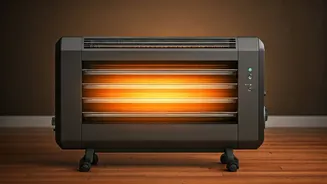Convector Heaters Explained
Convector heaters are a popular choice, and they work by circulating warm air throughout a room. These heaters draw in cold air, heat it using a heating
element, and then release the warm air into the room. A significant advantage is that they heat the air without directly heating the objects in the room, making them efficient for larger spaces. These units often come with adjustable thermostats, allowing users to control the desired temperature level. Some models feature a turbo fan, enabling faster heating by circulating the warm air more effectively. However, it's worth noting that convection heaters might take some time to heat a room as compared to some other types of heaters. They can be a good choice for continuous use in spaces like bedrooms or living areas.
Oil-Filled Radiators Unveiled
Oil-filled radiator heaters are another frequently chosen type, known for their ability to provide consistent and long-lasting warmth. These heaters utilize a sealed oil reservoir, which is heated by an electric element. The oil then radiates heat, warming the surrounding air. The beauty of these heaters is their ability to maintain a consistent temperature even after the heater is switched off, since the oil retains heat for some time. They are generally safe, as the outer surface doesn't become extremely hot. Although they take longer to heat up a room initially, they are incredibly efficient at maintaining a comfortable temperature over extended periods. Oil-filled radiators are often considered a great choice for bedrooms and other areas where a steady heat is preferred.
Fan Heaters Demystified
Fan heaters are compact and portable, known for their rapid heating capabilities. They use a heating element to warm air, which is then quickly blown out into the room by a fan. These heaters are ideal for immediate warmth, making them perfect for quickly heating a small space, such as a bathroom or a small office. Fan heaters usually have adjustable heat settings and sometimes also have a cool air option, enabling them to work as a fan in warmer months. However, the fan can be noisy, and they may consume more energy compared to other types. These heaters are often a great option when immediate and focused heating is needed, but they aren’t usually ideal for continuous operation in larger spaces.
Ceramic Heaters Explored
Ceramic heaters provide efficient heating using ceramic heating elements. These heaters are effective because ceramic has excellent heat-conducting properties, quickly warming up when electricity is applied. Many ceramic heaters are designed with oscillating features to distribute heat evenly across a room. This type of heater is typically energy-efficient and provides a steady warmth. They often come with safety features like automatic shut-off in case they tip over, which makes them user-friendly, especially in homes with kids or pets. Ceramic heaters are a smart choice for those who need a balance of safety, efficiency, and heating performance. They are suited for different room sizes, providing a comfortable warmth level.
Halogen Heaters Overview
Halogen heaters are known for producing instant warmth. These heaters use halogen lamps that generate heat through infrared radiation. The heat produced by a halogen heater directly warms people and objects, rather than the surrounding air, making them efficient at providing immediate warmth. They are usually more energy-efficient compared to some other types of heaters. Since they concentrate heat in a particular direction, they're often more effective in focused heating scenarios, such as when you’re relaxing in front of the television or working at a desk. These heaters are not always ideal for larger rooms since the heat distribution is directional. When choosing a halogen heater, look for models with safety features like a tip-over switch to avoid potential hazards.
Energy-Saving Features Explored
When choosing a room heater, it's essential to consider energy-saving features that can reduce electricity bills. Look for models with adjustable thermostats that allow you to manage the temperature, and select the desired warmth level rather than running the heater at maximum capacity constantly. Timers are also beneficial as they permit you to schedule the heater's operation. This prevents it from running unnecessarily. Automatic shut-off features are a crucial safety aspect, but they also contribute to energy conservation, as the heater turns off if it overheats or tips over. Many modern heaters include energy-saving modes, such as an eco-mode, which reduces power consumption while maintaining comfortable heating levels. By considering these features, you can make a choice that enhances comfort and reduces energy expenditure.
Safety First: Key Aspects
Prioritizing safety is paramount when buying and using room heaters. Always choose heaters with safety certifications from reputable organizations. These certifications confirm that the product has met safety standards. Make sure the heater has a tip-over switch, which automatically turns off the device if it’s accidentally knocked over. Do not place the heater too close to curtains, furniture, or any other flammable materials to prevent fire hazards. Avoid using extension cords, and always plug the heater directly into a wall outlet to prevent electrical overload. Regularly check the power cord for any wear and tear. If the cord is damaged, stop using the heater and have it repaired or replaced. By following these safety guidelines, you can ensure the safe and effective use of your room heater.
Room Size Considerations
Matching the room heater to the size of the space is crucial for both efficiency and comfort. For smaller rooms, such as a bedroom or a small office, a compact fan heater or a ceramic heater might be suitable. These heaters can quickly provide warmth and won’t overwhelm the room. In larger areas, like living rooms or dining areas, you might need a more powerful heater, such as a convector heater or an oil-filled radiator. These heaters can effectively heat a larger space and distribute the warmth evenly. Also, consider the insulation of the room. A well-insulated room will retain heat better, enabling you to use a less powerful heater compared to a poorly insulated room. Always check the wattage of the heater to ensure that it matches the room size and your electricity supply.
Top 10 Picks to Consider
Identifying the top 10 heaters for Indian homes will involve researching various models, focusing on factors such as energy efficiency, heating speed, safety features, and price. Some highly-rated brands include names that are known for reliability and customer satisfaction. The top models often include options from brands known for their innovation in heater technology. Each model should have different features like adjustable thermostats, safety features such as tip-over protection, and energy-saving modes. The best options often represent a balance of performance, safety, and energy efficiency, ensuring they meet the diverse needs of Indian consumers. Detailed reviews from users are essential for understanding the real-world performance of a heater.
Maintenance and Care Tips
Proper care and maintenance can extend the lifespan of your room heater and ensure its efficiency. Begin by regularly cleaning the heater, especially the air vents and any dust filters. Accumulated dust can reduce the heater's efficiency and potentially create a fire hazard. Unplug the heater and allow it to cool before cleaning it. Use a vacuum cleaner with a brush attachment or a soft cloth to clean the exterior of the heater. For oil-filled radiators, check the oil levels periodically (if applicable). Store the heater properly when not in use, by covering it to prevent dust accumulation. Inspect the power cord regularly for damage, and if there is any damage, the cord must be repaired or replaced by a qualified professional. Following these maintenance tips will help your room heater function safely and efficiently for many seasons.














